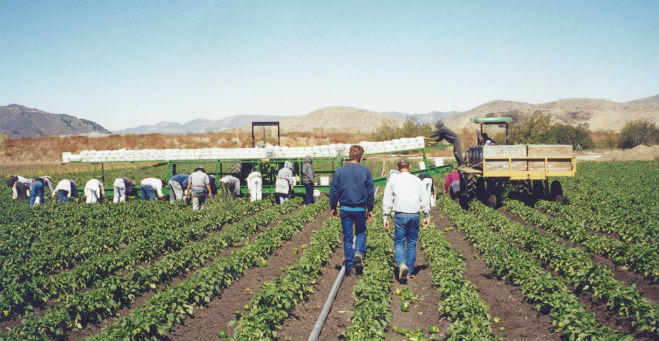

Aug 16, 2016Food safety, labor complicate vegetable growing at Uesugi Farms
Joe Aiello has seen plenty of changes since he bought Uesugi Farms in 1979, mainly in the areas of food safety, irrigation and labor.
Farming today requires complex management skills and greater patience – patience Joe has a hard time mustering, which makes him glad his son Pete has taken on much of the day-to-day management of the farm. Pete is more adept at dealing with all of the new regulations and expectations, his father said.
“I can get pretty negative about it, seeing what was and what is today,” Joe said.


Joe and a partner bought George Uesugi’s 150-acre farm in Morgan Hill, California, in 1979. Nearly four decades later, Uesugi Farms grows more than 5,000 acres of bell peppers, chili peppers, Napa cabbage, corn, pumpkins, strawberries and beans spread throughout California, Arizona and Mexico – growing, packing and shipping about 210,000 tons of vegetables a year.
Joe, now 68, said taking risks and having good people around had a lot to do with the farm’s growth.
Joe didn’t grow up on a farm, but his dad, who used to haul produce, helped Joe find jobs with some of the farmers he knew. When Joe graduated from Cal Poly in 1971, he and his wife Katie started farming a small plot of land his father had bought.
They rented a house on a parcel of land nearby, which happened to belong to local grower George Uesugi. That’s how Joe and George got to know each other.
In 1976, Joe planted 45 acres of processing tomatoes, but an inch and a half of rain hit on Aug. 20 and he lost the whole crop. He took a job as a foreman with a farming company to pay off his sizeable debt. Three years later, Dennis Humphreys, an equipment salesman he knew, told Joe that Uesugi’s health was failing, the grower had no successors and he wanted Joe and Humphreys to buy him out.




Peppers are Uesugi’s largest crop, by volume and acreage. The farm has expanded its pepper growing to nine regions – six in California, one in Arizona and two in Mexico. The multiple locations provide the farm with a year-round supply of bell and chili pepper varieties.
Probably the biggest change Joe has seen over the years is the increased emphasis on food safety.
When he started growing vegetables, “food safety” wasn’t even a concept. Today, Uesugi Farms has two employees whose entire responsibility is dealing with food safety audits. And the rules are strict. If you drop a pepper on the ground, you’re not supposed to put it back in the bucket, he said.
Drip irrigation is another big change. Joe installed his first drip system – under 16 acres of peppers – in 1984, at a time when drip was rare. That form of irrigation is much more common these days, he said.
And, of course, there’s the labor situation. There was an abundance of workers back in the ’70s. Big families would come in, live on the farm for a season, pick crops and head back home to Mexico or Southern California. But the labor supply is no longer abundant. Even Uesugi’s Mexican operation is short of workers these days, forcing the company to pull them in from further south, Joe said.
Uesugi Farms has about 50 year-round employees, but needs up to 600 at its peak. They’re trying different solutions to maintain that number: the H-2A federal guest-worker program and building new labor camps that include schools, doctors’ offices and churches. But H-2A is cumbersome, slow and expensive, and building labor camps in rural areas has its own share of bureaucratic hurdles, Joe said.
There’s also the prospect of a $15 minimum wage in California in the next few years, as well as new overtime rules, sick leave rules – things Joe never even thought about when he started farming, he said.
— Matt Milkovich, managing editor















